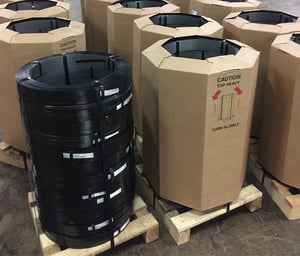 When moving large bundles of parts or materials long distances, companies often rely on some form of strapping to hold said loads in place. This is particularly true of large loads being conveyed on flatbeds, such as timber, steel I-beams, and the like.
When moving large bundles of parts or materials long distances, companies often rely on some form of strapping to hold said loads in place. This is particularly true of large loads being conveyed on flatbeds, such as timber, steel I-beams, and the like.
What the average consumer doesn’t know is that there are many different materials that can be used to make the straps holding down these loads. Some common banding/strapping materials that are used include:
- Steel
- Polyester
- Rubber
- Polypropylene
- Niloxy
Each of these strapping materials have different characteristics that could make one a better option than the others for your application.
For now, let’s contrast steel strapping vs. polyester strapping since these are the two most popular strapping materials.
What is Steel Strapping?
Steel strapping is a high tensile strapping made from various steel alloys. Of all the strapping materials in common use, steel strapping has the highest break strength—meaning it can hold the heaviest loads in place without breaking.
Steel strapping is an excellent material for holding parts or materials with sharp edges and hard corners, such as steel plates or I-beams, that could cut into softer materials. The rigidity of steel strapping makes it ideal for holding loads that are not prone to settling since the steel won’t readily lose its shape.
However, this rigidity can cause issues with loads that can settle or expand over the course of a shipment. For example, wooden logs can settle or, as they absorb moisture, expand—causing the load to loosen or the wood to crack and chafe.
The corrosion resistance of this strapping may vary depending on whether you use plain or stainless steel. Plain steel may become corroded during outdoor use if it rains. Stainless steel banding, on the other hand, can easily withstand exposure to rain, but may still show signs of discoloration if iron molecules from a plain steel I-beam or plate transfer onto the stainless steel strap.
Another characteristic that separates steel strapping from polyester bands is that steel straps are not susceptible to damage from prolonged exposure to ultraviolet rays. This allows prolonged use in extremely hot, sunny weather that could deteriorate some plastic derivatives, such as polyester or polypropylene.
Characteristics of Polyester Strapping
Strapping made from polyester compounds is quite a bit different from steel.
Unlike steel banding, polyester banding will elongate and contract along with a shifting load. This makes polyester a bit more flexible and adaptable to loads that can settle or shift during shipment, such as the wooden logs from the example cited in the steel bands section. Also, because polyester is a softer material, it’s less likely to abrade parts than steel.
However, this increased stretchiness and softness means that polyester bands are considerably less durable than steel ones are. Objects with sharp edges, such as metal sheets or I-beams, can cut through polyester strapping during transit—which is why these loads often require the use of edge protection pieces.
As a polymer, polyester has excellent corrosion resistance to most chemicals, so these bands can stand up to precipitation fairly well. However, polyester is, over prolonged periods of exposure, prone to decomposition from ultraviolet rays. This makes it considerably less durable than steel over long, cross-continental trips.
While not quite as strong as steel, polyester strapping break strength is still quite high, allowing it to be used for heavy loads without sharp edges.
Two of the primary reasons many manufacturers might use polyester rather than steel bands are:
- Cost. Polyester strapping is significantly less expensive than steel bands, and not as prone to cost fluctuations.
- Ease of Handling. Compared to steel, polyester bands are relatively easy to place and remove, and have less risk of severe injury to novice users. Some less experienced workers may underestimate the tension of a steel strap, and be lacerated by lashing metal when they cut it.
Which is Better for Your Application?
There are advantages and disadvantages to either strapping solution.
Your application might favor steel banding if:
- You’re transporting very large, heavy, stable loads.
- Your loads have sharp edges that could cut softer restraints.
- The load is being shipped very long distances.
- The load will experience multiple loading/unloading operations.
- The load is not sensitive to abrading from contact with steel.
Your application might favor polyester if:
- Your load may settle, expand, or contract during shipment.
- Your load is sensitive to abrasion and will be devalued if scratched or chipped.
- You have less experienced staff applying or removing the bands.
- The load is only traveling a relatively short distance.
Marlin Steel often uses steel or polyester banding for individual pallet loads of finished products depending on the situation—some loads are shipped in boxes without bands at all if the baskets are small enough.
The important thing is that the best solution is used to minimize risk of damage to the parts load for safe and efficient delivery. Using the wrong kind of strapping for the job can lead to damaged goods, excess scrap, and needing to remanufacture goods.
Using the right tool for the job is just one part of how Marlin Steel delivers “Quality, Engineered Quick®” to manufacturing clients all over the globe.



.gif)


